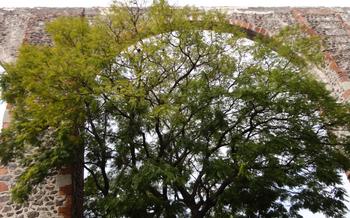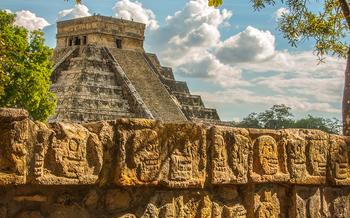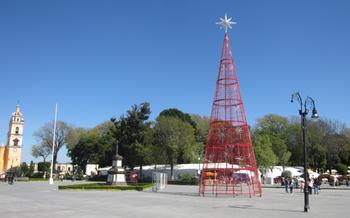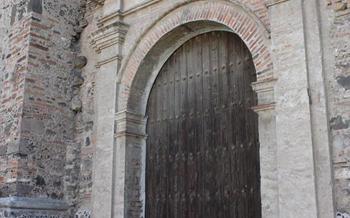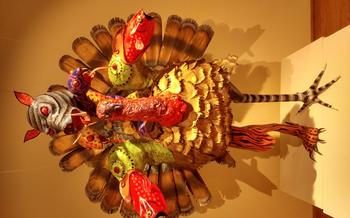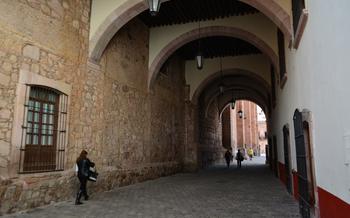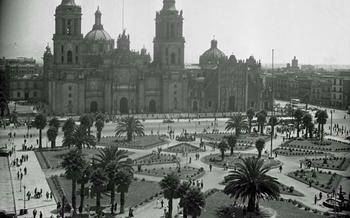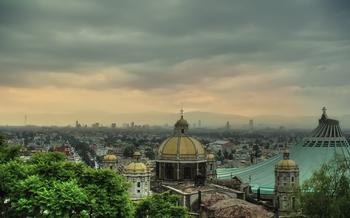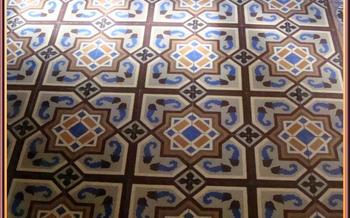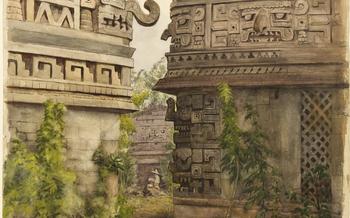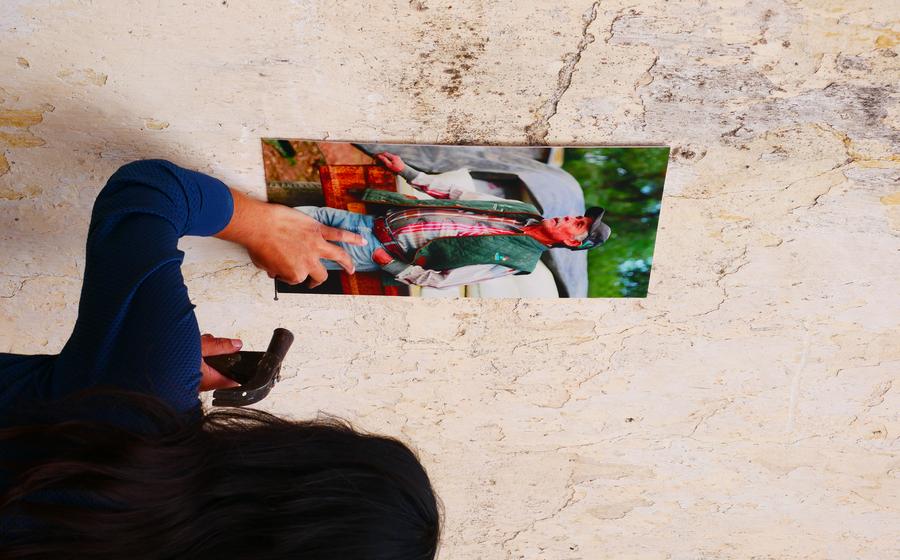
Casa Cortés
- Casa Cortés: A Historical Gem
- Step Inside the Casa Cortés
- The Legacy of Hernán Cortés
- Discover the Courtyard
- The Hall of Mirrors
- The Dining Room
- The Kitchen
- The Bedrooms
- The Chapel
- The Library
- The Archives
- The Garden
- The Stables
- The Servants' Quarters
- Insider Tip: Uncover Hidden Treasures
Casa Cortés: A Historical Gem
In the heart of Zacatecas, Mexico, lies a magnificent architectural treasure - the Casa Cortés. Built in the 16th century by Hernán Cortés, the renowned Spanish conquistador, this grand residence stands as a testament to his power and influence. The Casa Cortés is a masterpiece of colonial architecture, boasting intricate stone carvings, ornate balconies, and a sprawling courtyard that has witnessed centuries of history. With its well-preserved interiors and a wealth of artifacts, the house offers a captivating glimpse into the life and times of one of the most controversial figures in Mexican history.
Location and how to get there:
The Casa Cortés is situated in the historic center of Zacatecas, a city renowned for its colonial architecture and rich cultural heritage. To reach the house, visitors can take a leisurely stroll from the Plaza de Armas, the main square of the city. Alternatively, taxis and local buses are readily available to take visitors to the doorstep of this architectural gem.
Step Inside the Casa Cortés
Venturing into the Casa Cortés is like stepping back in time. Each room, meticulously preserved and adorned with authentic furnishings and artifacts, offers a glimpse into the life and times of the Cortés family.
The entrance hall, with its grand staircase and intricate tilework, sets the tone for the rest of the house. The walls are adorned with portraits of the Cortés family and their ancestors, while the floors are covered in rich carpets that muffle the sound of your footsteps.
As you explore the different rooms, you'll be struck by the attention to detail and the opulence of the furnishings. The dining room, with its long mahogany table and elaborate silver service, speaks to the family's wealth and status. The bedrooms, with their four-poster beds and silk curtains, offer a glimpse into the private lives of the Cortés family.
Throughout the house, you'll find fascinating artifacts that tell the story of the family's history. In the library, you'll see a collection of rare books and manuscripts that were once owned by Hernán Cortés himself. In the chapel, you'll find religious relics and artwork that attest to the family's deep faith.
A visit to the Casa Cortés is a journey through time, allowing you to experience firsthand the life and legacy of one of Mexico's most influential families.
The Legacy of Hernán Cortés
Hernán Cortés, a Spanish conquistador, played a pivotal role in the Spanish conquest of Mexico. His life was marked by ambition, courage, and a thirst for adventure. Born in Medellín, Spain, in 1485, Cortés arrived in the Americas in 1504 seeking fortune and glory. His military prowess and strategic alliances with indigenous groups led him to victory over the Aztec Empire in 1521, marking a significant turning point in Mexican history.
Cortés' relationship with the indigenous peoples was complex and often fraught with conflict. While he formed alliances with some indigenous groups, he also ruthlessly suppressed those who resisted Spanish rule. His actions had a profound impact on the indigenous population, leading to significant cultural, social, and political changes.
Cortés' legacy is a controversial one. While he is celebrated as a hero in Spain, he is often vilified in Mexico for his role in the destruction of the Aztec Empire and the exploitation of indigenous peoples. Nevertheless, his impact on the history of Mexico is undeniable, and his legacy continues to be debated and studied to this day.
Discover the Courtyard
A distinctive feature of the Casa Cortés is its central courtyard, a hallmark of colonial architecture. The courtyard serves as the heart of the house, providing a tranquil and inviting space for relaxation, social gatherings, and various domestic activities. Surrounding the courtyard are elegant arcades supported by graceful columns, creating a harmonious visual effect. These arcades are adorned with intricate carvings and decorative elements, reflecting the artistic prowess of the colonial artisans. The courtyard, with its surrounding arcades, forms an integral part of the house's design, contributing to its overall charm and functionality.
The Hall of Mirrors
Amidst the grand chambers of the Casa Cortés, the Hall of Mirrors stands as a testament to the opulence and extravagance of the colonial era. Its walls adorned with shimmering mirrors, reflecting and multiplying the grandeur of the room, create an ethereal and awe-inspiring ambiance. The intricate carvings and gilded frames surrounding each mirror add to the hall's majestic allure.
This resplendent hall served as a grand reception room, where the Cortés family welcomed distinguished guests and celebrated momentous occasions. The mirrors, imported from Europe, were a symbol of wealth and status, reflecting the family's power and influence. They also served a practical purpose, allowing the guests to admire their appearance and adjust their attire before entering the grand ballroom.
One notable story associated with the Hall of Mirrors is that of a young noblewoman who was so captivated by her reflection that she spent hours gazing at herself, oblivious to the world around her. The family, amused by her vanity, decided to play a trick on her. They secretly replaced one of the mirrors with a painting of a hideous monster, which caused the young woman to scream in horror when she caught sight of it. The incident became a humorous tale, often recounted at gatherings in the hall.
The Dining Room
The dining room of the Casa Cortés is a testament to the family's wealth and status. Elaborate furnishings and tableware adorn the room, creating an atmosphere of opulence and grandeur. Sumptuous feasts and banquets were held in this grand space, where guests were treated to a culinary journey that showcased the best of Mexican and Spanish cuisine. Stories abound of lavish entertainment and diplomatic gatherings, where the Cortés family entertained dignitaries and forged alliances. The dining room was not just a place for sustenance, but a stage for power plays and social maneuvering, where the family's influence and prestige were on full display.
The Kitchen
The kitchen of the Casa Cortés is a testament to the culinary traditions of Mexico and the blending of Spanish and indigenous influences. Here, traditional Mexican cuisine was elevated to new heights, as skilled cooks prepared sumptuous feasts and banquets that would impress even the most discerning palates. The kitchen was equipped with a variety of tools and utensils, from copper pots and clay comales to intricate mortars and pestles. Ingredients from both the Old and New Worlds were used to create dishes that combined the flavors of Europe with the rich spices and produce of Mexico.
The preparation of meals in the kitchen was a complex and time-consuming process, requiring the skillful hands of experienced cooks. They would grind corn into masa for tortillas, prepare moles with a variety of chiles and spices, and roast meats over open fires. The kitchen was also a place of experimentation, as new ingredients and cooking techniques were introduced from both sides of the Atlantic. The result was a unique and delectable cuisine that would leave a lasting impact on Mexican gastronomy.
One of the most famous dishes prepared in the kitchen of the Casa Cortés was the mole poblano, a complex and flavorful sauce made with a variety of chiles, spices, and chocolate. This dish, which originated in the city of Puebla, was a favorite of Hernán Cortés and would become one of the most iconic dishes of Mexican cuisine. Another popular dish was cochinita pibil, a slow-roasted pork dish marinated in achiote paste and wrapped in banana leaves. This dish, which originated in the Yucatán Peninsula, was also a favorite of the Cortés family and would become a staple of Mexican cuisine.
The kitchen of the Casa Cortés was not only a place of culinary excellence but also a place of social interaction. Here, the family would gather to share meals and stories, and to celebrate special occasions. It was also a place where the family would entertain guests, both from Spain and from Mexico. These guests would be treated to elaborate feasts, showcasing the wealth and power of the Cortés family.
The kitchen of the Casa Cortés is a reminder of the rich culinary traditions of Mexico and the important role that the Cortés family played in shaping these traditions. It is a place where history and gastronomy come together, creating a unique and unforgettable experience for visitors.
The Bedrooms
The bedrooms of the Casa Cortés offer a glimpse into the private lives of the family. The master bedroom is particularly impressive, with its ornate bed frame, luxurious tapestries, and a private balcony overlooking the courtyard. The other bedrooms are more modest but still well-appointed, with comfortable beds, sturdy furniture, and personal touches such as family portraits and religious icons.
The daily routines and rituals of the Cortés family were centered around the bedrooms. Here, they would wake up at dawn to the sound of the chapel bell, dress for the day ahead, and exchange stories and gossip with their servants. In the evenings, they would gather in the master bedroom to pray, read, and spend time together as a family.
The bedrooms also hold stories of family life and domestic affairs. It is said that Hernán Cortés and his wife, Juana de Zúñiga, had several children who were born and raised in the Casa Cortés. The children would play in the bedrooms, hide-and-seek in the secret passageways, and listen to their parents' stories about their adventures in the New World.
The Chapel
Deep within the Casa Cortés, a sanctuary of faith and devotion awaits visitors. The chapel, a testament to the religious beliefs of the Cortés family, holds a significant place in the household. It served as a private space for prayer, reflection, and the observance of religious rituals.
The chapel's interior is adorned with intricate religious iconography, including paintings, sculptures, and stained-glass windows. The altar, the focal point of the chapel, features a beautiful image of the Virgin Mary, surrounded by candles and flowers.
The Cortés family, deeply rooted in the Catholic faith, used the chapel for daily prayers, masses, and special religious occasions. They sought solace and guidance within its sacred walls, finding strength in their beliefs amidst the trials and tribulations of their daily lives.
Stories are told of the family's deep devotion to their faith. Hernán Cortés himself was known for his piety, and he often spent hours in contemplation and prayer within the chapel. His wife, Doña Juana de Zúñiga, was equally devout, and she ensured that the chapel was always adorned and cared for with the utmost reverence.
The chapel of the Casa Cortés stands as a testament to the enduring power of faith and the role it played in the lives of this influential family. Visitors to the house can experience the tranquility and spirituality of this sacred space, gaining a deeper understanding of the religious beliefs that shaped the lives of the Cortés family.
The Library
A treasure trove of knowledge awaited within the walls of the Casa Cortés library. Books and manuscripts from around the world lined the shelves, reflecting the family's passion for learning and education. History, philosophy, science, and literature filled the air with an intoxicating scent of knowledge.
The library was not merely a collection of books but a testament to the family's intellectual pursuits. Don Hernán, a voracious reader, spent countless hours in this sanctuary, devouring the wisdom contained within the pages. His sons and daughters, inspired by their father's example, developed a deep appreciation for the written word.
The library served as a gathering place for scholars, intellectuals, and dignitaries, who engaged in lively debates and discussions on a wide range of topics. The exchange of ideas and perspectives enriched the minds of all who entered this sacred space.
Among the library's most prized possessions was a collection of ancient Mesoamerican codices, carefully preserved by the Cortés family. These precious manuscripts offered a glimpse into the rich history and culture of the indigenous peoples, a subject of great fascination for Don Hernán.
The library at Casa Cortés stands as a monument to the family's commitment to knowledge and enlightenment, a legacy that continues to inspire generations to come.
The Archives
The Casa Cortés is also home to an extensive archive, containing a wealth of historical documents and records that provide valuable insights into the family's financial dealings, political activities, and personal lives. These documents include account books, correspondence, legal papers, and genealogical records, which have been meticulously preserved and cataloged over the years.
The archives offer a fascinating glimpse into the intricate workings of a prominent colonial family, shedding light on their financial strategies, their relationships with the Spanish Crown, and their interactions with the indigenous population. Researchers and historians have spent countless hours poring over these documents, uncovering stories of intrigue, power struggles, and the complex interplay between the Spanish and indigenous cultures.
One of the most intriguing stories revealed by the archives is the financial dealings of Hernán Cortés. As the conqueror of Mexico, Cortés amassed a vast fortune, much of which was invested in land, mining, and trade. The archives contain detailed records of his financial transactions, including his purchases of haciendas, his investments in silver mines, and his trade agreements with merchants from Spain and other parts of the world.
Another fascinating aspect of the archives is the correspondence between Hernán Cortés and his family members, as well as with other prominent figures of the time. These letters provide a glimpse into the personal lives of the Cortés family, their hopes, their fears, and their relationships with each other. They also shed light on the political and social landscape of colonial Mexico, as Cortés corresponded with viceroys, church officials, and indigenous leaders.
The Casa Cortés archives are a treasure trove of information for anyone interested in the history of Mexico, the Spanish conquest, and the life of Hernán Cortés. They provide a unique window into the past, offering insights into the financial, political, and personal affairs of one of the most influential families in colonial Mexico.
The Garden
In the heart of the Casa Cortés, a lush garden unfolds, offering a sanctuary of tranquility and beauty. A riot of colors and fragrances fills the air as vibrant flowers bloom in profusion, their petals shimmering in the warm Mexican sun. Cascading bougainvillea drapes the walls in a cascade of purple, while delicate jasmine twirls its tendrils, releasing a heady scent that perfumes the air.
Beyond the vibrant blooms, the garden reveals a variety of fruit trees, their branches laden with ripening mangoes, oranges, and avocados, a testament to the fertility of the Zacatecas soil. The rustling leaves of the trees create a symphony of sound, while the gentle breeze carries the sweet aroma of ripening fruit.
At the center of the garden, a fountain gurgles softly, its crystal-clear waters providing a refreshing respite from the heat. Surrounding the fountain, a mosaic of colorful tiles depicts scenes from Mexican mythology, their vibrant hues adding a touch of magic to the serene setting.
In the shade of a majestic oak tree, a stone bench invites visitors to pause and savor the tranquility of the garden. Here, one can lose themselves in the beauty of nature, surrounded by the vibrant colors and intoxicating fragrances of the Mexican flora.
The Stables
Horses were essential for transportation, communication, and warfare in colonial Mexico. The Casa Cortés had its own stables, where the family's horses were kept and cared for. The stables were spacious and well-ventilated, with individual stalls for each horse. The horses were groomed and fed regularly, and their hooves were trimmed by a skilled blacksmith.
The Cortés family took great pride in their horses, and they were often used for riding, hunting, and other equestrian activities. Hernán Cortés himself was a skilled horseman, and he often led his troops into battle on horseback. The family's horses were also used to transport goods and messages between the Casa Cortés and other haciendas and settlements.
One of the most famous horses in the Cortés family was a black stallion named Azabache. Azabache was Hernán Cortés's favorite horse, and he was said to be a fearless and tireless mount. Azabache carried Cortés through many battles, and he was instrumental in the Spanish conquest of Mexico.
The Servants' Quarters
The servants' quarters, located in a separate wing of the Casa Cortés, provided accommodations for the household's domestic staff. These individuals played a crucial role in the functioning of the household, performing a wide range of tasks essential for the comfort and well-being of the Cortés family. They included cooks, maids, gardeners, stable boys, and other laborers who worked tirelessly to maintain the estate.
The living conditions of the servants were modest, reflecting the social hierarchy of the time. Their quarters were typically small and sparsely furnished, with simple beds, wooden chests, and a few basic necessities. Despite their humble surroundings, the servants were treated with respect and compassion by the Cortés family, who recognized their indispensable contributions to the household.
Their daily life was filled with hard work and long hours. They rose early to prepare breakfast for the family and then spent the rest of the day performing their assigned duties. In the evenings, they gathered in the kitchen to share stories and experiences, finding solace and companionship in one another.
Among the servants, there were those who had been with the Cortés family for many years, forming deep bonds of loyalty and affection. They were entrusted with the family's secrets and often became confidants to the master and mistress of the house. Their stories of dedication and unwavering service provide a glimpse into the human side of the Casa Cortés, revealing the complex relationships that existed between the family and their staff.
Insider Tip: Uncover Hidden Treasures
Beyond the visible wonders of the Casa Cortés, there lies a realm of hidden treasures waiting to be discovered. Secret passageways and concealed chambers, once known only to the family and their trusted confidants, invite you on an exhilarating journey of exploration. Rumor has it that these hidden spaces hold a collection of priceless artifacts, heirlooms passed down through generations, and treasures amassed during the family's storied history. As you venture into these secret realms, you'll feel like an intrepid explorer uncovering the mysteries of a forgotten world. With each step, the thrill of discovery intensifies, as you come face to face with the hidden treasures of the Casa Cortés.
